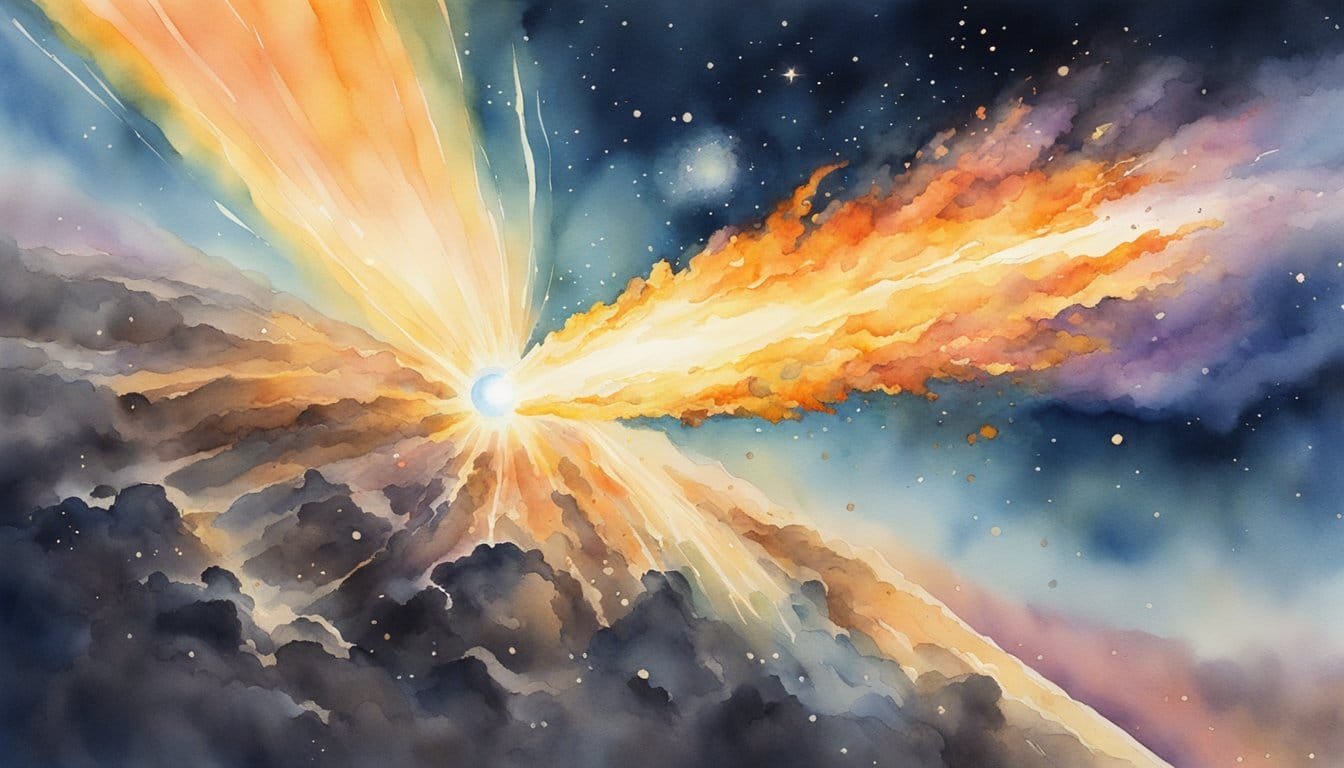Comet 2024 Overview
Comet 2024 has captivated both amateur and professional astronomers alike, offering an exciting opportunity to observe a unique celestial event as it blazes through the night sky.
Essential Characteristics
Comet 2024, also known as Comet 12P/Pons-Brooks after its co-discoverers Jean-Louis Pons and William Brooks, is unique in its composition and trajectory. Traveling through the solar system, this comet has an orbital period that brings it into the inner part of the solar system, near the Earth and the Sun, roughly every 71 years. The perihelion, or the point in the comet’s orbit closest to the Sun, is a critical time when the comet’s brightness significantly increases and its iconic tail—composed of gas, dust, and ice—becomes most prominent.
Observation Tips
To observe Comet 2024, stargazers should look to the sky during the comet’s perihelion, when it will be brightest. The comet can be visible to the naked eye under dark, clear skies, but for the best experience, using binoculars or a telescope is recommended. This will allow observers to see finer details of the comet’s coma, the nebulous envelope around the nucleus, and even the detailed structure within the tail. It’s important to note that the comet’s magnitude, or brightness, will fluctuate, and consulting an astronomy guide for the best viewing times is advised.
Historical Significance
Comet 12P/Pons-Brooks holds a special place in the history of astronomy. Discovered in the 19th century, it has been observed multiple times by astronomers around the world. Its historical passages near Earth have contributed valuable data to our understanding of cometary behavior and the materials present in these ancient wanderers of the solar system. At its discovery, the distance from the comet to the Sun was measured in astronomical units, which helped to expand our knowledge of the vast distances in space.
Notable Comets and Events

The night sky of 2024 brings with it a celestial parade of comets and astronomical events that illuminate the heavens and inspire both seasoned astronomers and stargazers alike.
Famous Comets
The return of Comet Pons-Brooks (12P/Pons-Brooks), with its roughly 71-year orbit, offers a rare glimpse into the past of comet observations. This Halley-type comet, last seen in 1954, will be visiting from the depths of the Oort Cloud, a vast reservoir of icy bodies where most long-period comets originate. Another visitor, Comet Tsuchinshan-Atlas (C/2021 S3), is expected to reach its peak brightness, visible in binoculars or small telescopes to observers in the Southern Hemisphere. Meanwhile, Comet 333P/LINEAR continues to dazzle the astronomy community with its unpredictable outbursts, much like the infamous ‘Devil Comet’ of lore.
Observation Opportunities
Sky enthusiasts can look forward to the total solar eclipse on April 8, 2024, when the moon’s shadow will trace a path across North America, offering a unique backdrop for comet sightings near the point of totality. Amidst the solar eclipse, Venus and Jupiter will serve as bright guides, visible near the eclipsed Sun. For those in the Northern Hemisphere, observing the ecliptic in early evening will reveal comets against constellations such as Leo, Libra, and Virgo, adorning the western sky.
Amateur Astronomy and Citizen Science
Amateur astronomers play a vital role in comet science, often being the first to spot new comets or detect changes in existing ones. With tools like the Comet Observation Database, and apps like SkySafari, even casual observers can track comet paths and contribute valuable data. Astrophotographers like Gideon van Buiten and Seiichi Yoshida continuously update the community with stunning images and insights, turning amateur astronomy into a collaborative science frontier.
How Does the ISS Experience Comets Like Comet 2024?
As comets like Comet 2024 approach the Earth, the International Space Station (ISS) offers a unique vantage point for scientists. They can observe these celestial bodies while exploring the iss earthly mortgage of their velocity and trajectory. This research enhances our understanding of comets and their potential impacts on Earth.
Impacts and Interactions

Comets like the spectacular Comet 2024 offer a cosmic spectacle as they interact with the various elements of our solar system. These icy vagabonds, with their fascinating outbursts and tails, weave through our cosmic neighborhood, leaving a trail of scientific excitement and cultural influence in their wake.
Comet Encounters
When comets approach the Earth, they can bring with them a range of interactions. From the potential of impact with earthly objects, comparable to the force of multiple nuclear bombs, to a gravity assist which can change their course, these encounters are pivotal. The Earth’s own gravitational field can tug on a comet’s nucleus, sometimes leading to spectacular outbursts of material that add to its coma or tail.
Cometary Phenomena
The nucleus of a comet, which may be up to the size of Mount Everest, acts as the heart from which stunning phenomena arise. Outbursts can occur when a comet, heated by the sun, spews out gas and dust. This can temporarily increase the comet’s brightness and create a tail that stretches across the sky for millions of miles, a breathtaking feature often observed with the naked eye from Earth.
Cultural and Media Impact
Comets like Comet 2024 don’t just leave their mark in the stars; they also imprint on human culture and media. They capture the imagination, featuring in everything from blockbuster movies, suggesting a maverick spaceship like the Millennium Falcon dodging through an asteroid field, to inspiring introspective artworks that reflect on our place in the universe. Even in science fiction, where authors imagine visiting these celestial bodies, comets symbolize both the perils and the infinite possibilities of space exploration.
Note: For a better comprehension of the section contents, a list has been avoided, and the formatting has been designed to cater to better readability and retention of information.

